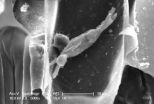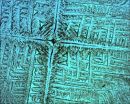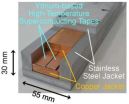(Press-News.org) New research at the University of Adelaide has opened the way for the development of new lines of barley with resistance to powdery mildew.
In Australia, annual barley production is second only to wheat with 7-8 million tonnes a year. Powdery mildew is one of the most important diseases of barley.
Senior Research Scientist Dr Alan Little and team have discovered the composition of special growths on the cell walls of barley plants that block the penetration of the fungus into the leaf.
The research, by the ARC Centre of Excellence in Plant Cell Walls in the University's School of Agriculture, Food and Wine in collaboration with the Leibniz Institute of Plant Genetics and Crop Plant Research in Germany, will be presented at the upcoming 5th International Conference on Plant Cell Wall Biology and published in the journal New Phytologist .
"Powdery mildew is a significant problem wherever barley is grown around the world," says Dr Little. "Growers with infected crops can expect up to 25% reductions in yield and the barley may also be downgraded from high quality malting barley to that of feed quality, with an associated loss in market value.
"In recent times we've seen resistance in powdery mildew to the class of fungicide most commonly used to control the disease in Australia. Developing barley with improved resistance to the disease is therefore even more important."
The discovery means researchers have new targets for breeding powdery mildew resistant barley lines.
"Powdery mildew feeds on the living plant," says Dr Little. "The fungus spore lands on the leaf and sends out a tube-like structure which punches its way through cell walls, penetrating the cells and taking the nutrients from the plant. The plant tries to stop this penetration by building a plug of cell wall material – a papillae – around the infection site. Effective papillae can block the penetration by the fungus.
"It has long been thought that callose is the main polysaccharide component of papilla. But using new techniques, we've been able to show that in the papillae that block fungal penetration, two other polysaccharides are present in significant concentrations and play a key role.
"It appears that callose acts like an initial plug in the wall but arabinoxylan and cellulose fill the gaps in the wall and make it much stronger."
In his PhD project, Jamil Chowdhury showed that effective papillae contained up to four times the concentration of callose, arabinoxylan and cellulose as cell wall plugs which didn't block penetration.
"We can now use this knowledge find ways of increasing these polysaccharides in barley plants to produce more resistant lines available for growers," says Dr Little.
INFORMATION:
Media Contacts:
Dr Alan Little
Senior Research Scientist
ARC Centre of Excellence in Plant Cell Walls
School of Agriculture, Food and Wine
The University of Adelaide
Phone: +61 8 8313 7260
Mobile: +61 (0)439 309 950
alan.little@adelaide.edu.au
Robyn Mills
Media Officer
The University of Adelaide
Phone: +61 8 8313 6341
Mobile: +61 410 689 084
robyn.mills@adelaide.edu.au
New hope for powdery mildew resistant barley
2014-07-25
ELSE PRESS RELEASES FROM THIS DATE:
NRG1 isoforms could be an effective therapeutic candidate to promote peripheral nerve regeneration
2014-07-25
Neuregulin 1 (NRG1) is a pleiotropic factor characterized by the existence of numerous isoforms arising from alternative splicing of exons that confer to the protein deeply different characteristics. NRG1 plays an important role for both the myelination occurring during development and the different phases occurring after injury in the peripheral nerve: axon degeneration, axon regrowth, remyelination and target reinnervation
Researchers at the University of Western Australia have discovered that the soluble NRG1 upregulation observed in Schwann cells immediately after ...
Assessment on self-care ability of children with spina bifda
2014-07-25
Spina bifda (SB) is a complex congenital central nervous system disease that is caused by the incomplete closing of the neural tubes during the embryonic phase. Many patients have varying degrees of spasticity, urinary and fecal incontinence and neurocognitive retardation. Such problems decrease the patients' functional independence and their quality of life. Researchers at Ankara Physical Medicine and Rehabilitation Education and Research Hospital, Turkey investigate the functional performance in children with SB, using the Pediatric Evaluation of Disability Inventory ...
Neurologic recovery from corticospinal tract injury due to subfalcine herniation
2014-07-25
After development of diffusion tensor tractography (DTT), which is derived from diffusion tensor imaging (DTI), three-dimensional reconstruction and estimation for three motor tracts, such as the corticospinal tract, the rubrospinal tract, and the corticoreticular pathway became possible. The corticospinal tract is known to be a major neural tract for motor function in the human brain. Several studies have reported on injury of the corticospinal tract by transtentorial herniation. In addition, some studies have demonstrated recovery of a corticospinal tract injured by transtentorial ...
Bacteria manipulate salt to build shelters to hibernate
2014-07-25
For the first time, Spanish researchers have detected an unknown interaction between microorganisms and salt. When Escherichia coli cells are introduced into a droplet of salt water and is left to dry, bacteria manipulate the sodium chloride crystallisation to create biomineralogical biosaline 3D morphologically complex formations, where they hibernate. Afterwards, simply by rehydrating the material, bacteria are revived. The discovery was made by chance with a home microscope, but it made the cover of the Astrobiology journal and may help to find signs of life on other ...
Breakthrough laser experiment reveals liquid-like motion of atoms in an ultra-cold cluster
2014-07-25
A new study by researchers from the University of Leicester has furthered our understanding of how tiny nanosystems function, unlocking the potential to create new materials using nanosized 'building blocks'.
The study, which has been published in the prestigious academic journal Physical Review Letters, used a novel laser technique to examine in rich detail the structure and internal atomic motion of a small cluster containing an acetylene molecule and a single helium atom.
The technique excited single clusters and generated rotational wavepackets, which are composed ...
Magnets for fusion energy: A revolutionary manufacturing method developed
2014-07-25
The National Institute for Fusion Science (NIFS), of the National Institutes of Natural Sciences (NINS) in Japan, has achieved an electrical current of 100,000 amperes, which is by far the highest in the world, by using the new idea of assembling the state-of-the-art yttrium-based high-temperature superconducting tapes to fabricate a large-scale magnet conductor.
NIFS is undertaking the development of a high-temperature superconducting coil that is appropriate for the fusion reactor magnet. Using the state-of-the-art yttrium-based high-temperature superconducting tapes ...
Physicists create tool to foresee language destruction impact and thus prevent it
2014-07-25
There have been numerous cases of cultural changes throughout history. Either by imposition or assimilation, cultural traits are transmitted between neighbouring regions and often one replaces the original cultural traits of the other. Physicists Joaquim Fort, from the University of Girona (UdG), and Neus Isern, from the Universitat Autònoma de Barcelona (UAB), are experts in modelling these phenomena by adequately representing a reality, as they have demonstrated with their previous projects.
In this occasion, the researchers applied their expertise to the area of language ...
Collecting just the right data
2014-07-25
Much artificial-intelligence research addresses the problem of making predictions based on large data sets. An obvious example is the recommendation engines at retail sites like Amazon and Netflix.
But some types of data are harder to collect than online click histories —information about geological formations thousands of feet underground, for instance. And in other applications — such as trying to predict the path of a storm — there may just not be enough time to crunch all the available data.
Dan Levine, an MIT graduate student in aeronautics and astronautics, and ...
Could age of first period influence development of diseases in older women?
2014-07-25
BOSTON—A novel study shows that the age girls reach puberty is influenced by 'imprinted genes'—a subset of genes whose activity differs depending on which parent contributes the gene. This is the first evidence that imprinted genes can control the rate of development after birth and details of this study were published today in the journal Nature.
Age of the first period, known as menarche, is a marker for the timing of puberty in females. Medical evidence shows that the onset of menses varies between girls, is an inherited trait, and is linked to breast cancer, diabetes ...
It takes two to court
2014-07-25
KANSAS CITY, MO—Researchers at the Stowers Institute for Medical Research have identified the functions of two classes of pheromone receptors, and found pheromones crucial to triggering the mating process in mice.
They found one class of receptors helps a male mouse detect pheromones that indicate when a female is present. The other class of receptors lets him know if the female mouse is ovulating and ready to mate. Both sets of pheromones are critical to trigger mating. Stowers' researchers believe mice developed this system through evolution to maximize the chance of ...




